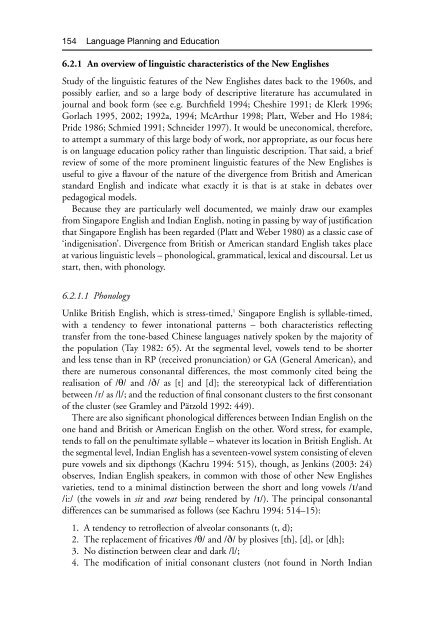Gibson Ferguson Language Planning and Education Edinburgh ...
Gibson Ferguson Language Planning and Education Edinburgh ...
Gibson Ferguson Language Planning and Education Edinburgh ...
Create successful ePaper yourself
Turn your PDF publications into a flip-book with our unique Google optimized e-Paper software.
154 <strong>Language</strong> <strong>Planning</strong> <strong>and</strong> <strong>Education</strong><br />
6.2.1 An overview of linguistic characteristics of the New Englishes<br />
Study of the linguistic features of the New Englishes dates back to the 1960s, <strong>and</strong><br />
possibly earlier, <strong>and</strong> so a large body of descriptive literature has accumulated in<br />
journal <strong>and</strong> book form (see e.g. Burchfield 1994; Cheshire 1991; de Klerk 1996;<br />
Gorlach 1995, 2002; 1992a, 1994; McArthur 1998; Platt, Weber <strong>and</strong> Ho 1984;<br />
Pride 1986; Schmied 1991; Schneider 1997). It would be uneconomical, therefore,<br />
to attempt a summary of this large body of work, nor appropriate, as our focus here<br />
is on language education policy rather than linguistic description. That said, a brief<br />
review of some of the more prominent linguistic features of the New Englishes is<br />
useful to give a flavour of the nature of the divergence from British <strong>and</strong> American<br />
st<strong>and</strong>ard English <strong>and</strong> indicate what exactly it is that is at stake in debates over<br />
pedagogical models.<br />
Because they are particularly well documented, we mainly draw our examples<br />
from Singapore English <strong>and</strong> Indian English, noting in passing by way of justification<br />
that Singapore English has been regarded (Platt <strong>and</strong> Weber 1980) as a classic case of<br />
‘indigenisation’. Divergence from British or American st<strong>and</strong>ard English takes place<br />
at various linguistic levels – phonological, grammatical, lexical <strong>and</strong> discoursal. Let us<br />
start, then, with phonology.<br />
6.2.1.1 Phonology<br />
Unlike British English, which is stress-timed, 1 Singapore English is syllable-timed,<br />
with a tendency to fewer intonational patterns – both characteristics reflecting<br />
transfer from the tone-based Chinese languages natively spoken by the majority of<br />
the population (Tay 1982: 65). At the segmental level, vowels tend to be shorter<br />
<strong>and</strong> less tense than in RP (received pronunciation) or GA (General American), <strong>and</strong><br />
there are numerous consonantal differences, the most commonly cited being the<br />
realisation of /θ/ <strong>and</strong> /ð/ as [t] <strong>and</strong> [d]; the stereotypical lack of differentiation<br />
between /r/ as /l/; <strong>and</strong> the reduction of final consonant clusters to the first consonant<br />
of the cluster (see Gramley <strong>and</strong> Pätzold 1992: 449).<br />
There are also significant phonological differences between Indian English on the<br />
one h<strong>and</strong> <strong>and</strong> British or American English on the other. Word stress, for example,<br />
tends to fall on the penultimate syllable – whatever its location in British English. At<br />
the segmental level, Indian English has a seventeen-vowel system consisting of eleven<br />
pure vowels <strong>and</strong> six dipthongs (Kachru 1994: 515), though, as Jenkins (2003: 24)<br />
observes, Indian English speakers, in common with those of other New Englishes<br />
varieties, tend to a minimal distinction between the short <strong>and</strong> long vowels /i/<strong>and</strong><br />
/i:/ (the vowels in sit <strong>and</strong> seat being rendered by /i/). The principal consonantal<br />
differences can be summarised as follows (see Kachru 1994: 514–15):<br />
1. A tendency to retroflection of alveolar consonants (t, d);<br />
2. The replacement of fricatives /θ/ <strong>and</strong> /ð/ by plosives [th], [d], or [dh];<br />
3. No distinction between clear <strong>and</strong> dark /l/;<br />
4. The modification of initial consonant clusters (not found in North Indian






